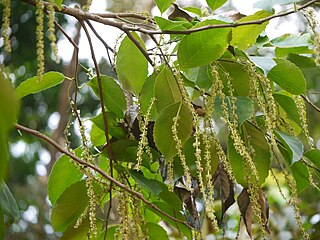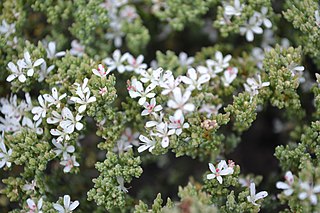
Nikolai Stepanovich Turczaninow was a Russian botanist and plant collector who first identified several genera, and many species, of plants.

Robinsonella is a genus of flowering plants in the family Malvaceae. It contains sixteen species of trees occurring from Costa Rica to southern Mexico, eight of which occur in the Mexican state of Chiapas.

Homalium is a genus of plants in the family Salicaceae.
Zinowiewia is a genus of flowering plants in the family Celastraceae. It includes 14 species native to the tropical Americas, ranging from northeastern Mexico to French Guiana and Bolivia.
Dictamnus is a genus of flowering plant in the family Rutaceae, native to temperate Eurasia from Spain to China. The genus was first described by Carl Linnaeus in 1753.

Heliocarpus is a genus of flowering plants in the family Malvaceae. It was formerly classified in the Tiliaceae.
Latrobea is a genus of flowering plants in the legume family, Fabaceae. It includes eight species of shrubs endemic to Southwest Australia. Typical habitats include forest, woodland, and heathland on sandy soils and swampy areas in higher-rainfall areas of the far southwest. The genus belongs to the subfamily Faboideae. The plant is named after Charles Joseph La Trobe.
Endocellion is a small genus of flowering plants in the daisy family Asteraceae.

Ceratogyne is a genus of flowering plants in the family Asteraceae.
Geleznowia is a small genus of flowering plants in the family Rutaceae.

Frankenia is the only genus in the Frankeniaceae family of flowering plants. Other genera have been recognized within the family, such as Anthobryum, Hypericopsis and Niederleinia, but molecular phylogenetic studies have consistently shown that they all belong inside Frankenia. Frankenia comprises about 70–80 species of shrubs, subshrubs and herbaceous plants, adapted to saline and dry environments throughout temperate and subtropical regions. A few species are in cultivation as ornamental plants.

Zabelia is a genus of flowering plants in the family Caprifoliaceae. It includes eight species native to temperate Asia, ranging from Central Asia through the Himalayas to China, Korea, and Japan.
Xerosollya is a genus of flowering plants belonging to the family Pittosporaceae.
Anticoryne is a genus of flowering plants belonging to the family Myrtaceae.
Diplolophium is a genus of flowering plants belonging to the family Apiaceae.
Lophiocarpus is a genus of flowering plants belonging to the family Lophiocarpaceae.
Molopanthera is a genus of flowering plants belonging to the family Rubiaceae.

Phlojodicarpus is a genus of flowering plants belonging to the family Apiaceae.
Lithosciadium is a genus of flowering plants belonging to the family Apiaceae.
Hansenia is a genus of flowering plant in the family Apiaceae, native to from Siberia to China. The genus was first described by Nikolai Turczaninow in 1844.







